A New Graphic Type Differentiation of Cell Account Determination for Distinguishing Acute Periprosthetic Joint Infection from Hemarthrosis
Abstract
:1. Introduction
- Can different types (infection type, hematoma type, and mixed type of infection and hematoma) be differentiated in the LMNE matrix?
- Does this type differentiation help in the diagnosis of acute periprosthetic infection?
2. Materials and Methods
3. Results
4. Discussion
5. Conclusions
Author Contributions
Funding
Institutional Review Board Statement
Informed Consent Statement
Data Availability Statement
Conflicts of Interest
References
- Bedair, H.; Ting, N.; Jacovides, C.; Saxena, A.; Moric, M.; Parvizi, J.; Della Valle, C.J. The Mark Coventry Award: Diagnosis of Early Postoperative TKA Infection Using Synovial Fluid Analysis. Clin. Orthop. Relat. Res. 2011, 469, 34–40. [Google Scholar] [CrossRef] [PubMed]
- Kim, S.-G.; Kim, J.-G.; Jang, K.-M.; Han, S.-B.; Lim, H.-C.; Bae, J.-H. Diagnostic Value of Synovial White Blood Cell Count and Serum C-Reactive Protein for Acute Periprosthetic Joint Infection After Knee Arthroplasty. J. Arthroplast. 2017, 32, 3724–3728. [Google Scholar] [CrossRef] [PubMed]
- Yi, P.H.; Cross, M.B.; Moric, M.; Sporer, S.M.; Berger, R.A.; Della Valle, C.J. The 2013 Frank Stinchfield Award: Diagnosis of Infection in the Early Postoperative Period After Total Hip Arthroplasty. Clin. Orthop. Relat. Res. 2013, 472, 424–429. [Google Scholar] [CrossRef]
- Ohdera, T.; Tokunaga, M.; Hiroshima, S.; Yoshimoto, E.; Matsuda, S. Recurrent hemarthrosis after knee joint arthroplasty: Etiology and treatment. J. Arthroplast. 2004, 19, 157–161. [Google Scholar] [CrossRef] [PubMed]
- Ravi, B.; Hosack, L.; Backstein, D.; Spangehl, M. Recurrent hemarthrosis after total knee arthroplasty: Evaluation and treatment. J. Am. Acad. Orthop. Surg. 2019, 27, 652–658. [Google Scholar] [CrossRef] [PubMed]
- Yu, B.-Z.; Fu, J.; Chai, W.; Hao, L.-B.; Chen, J.-Y. Neutrophil to lymphocyte ratio as a predictor for diagnosis of early Periprosthetic joint infection. BMC Musculoskelet. Disord. 2020, 21, 1–7. [Google Scholar] [CrossRef] [PubMed]
- Parvizi, J.; Zmistowski, B.; Berbari, E.F.; Bauer, T.W.; Springer, B.D.; Della Valle, C.J.; Garvin, K.L.; Mont, M.A.; Wongworawat, M.D.; Zalavras, C.G. New definition for periprosthetc joint infection: From the Workgroup of the Musculoskeletal Infection Society. Clin. Orthop. Relat. Res. 2011, 469, 2992–2994. [Google Scholar] [CrossRef]
- Parvizi, J.; Tan, T.L.; Goswami, K.; Higuera, C.; Della Valle, C.; Chen, A.F.; Shohat, N. The 2018 Definition of Periprosthetic Hip and Knee Infection: An Evidence-Based and Validated Criteria. J. Arthroplast. 2018, 33, 1309–1314.e2. [Google Scholar] [CrossRef]
- Workgroup Convened by the Musculoskeletal Infection Society. New definition for periprosthetic joint infection. J. Arthroplast. 2011, 26, 1136–1138. [Google Scholar] [CrossRef]
- Sukhonthamarn, K.; Tan, T.L.; Xu, C.; Kuo, F.-C.; Lee, M.S.; Citak, M.; Gehrke, T.; Goswami, K.; Parvizi, J. Determining Diagnostic Thresholds for Acute Postoperative Periprosthetic Joint Infection. J. Bone Jt. Surg. 2020, 102, 2043–2048. [Google Scholar] [CrossRef]
- Parvizi, J.; Gehrke, T. International Consensus Group on Periprosthetic Joint Infection. Definition of periprosthetic joint infection. J. Arthroplast. 2014, 29, 1331. [Google Scholar] [CrossRef] [PubMed]
- Fink, B.; Hoyka, M.; Weissbarth, E.; Schuster, P.; Berger, I. The Graphical Representation of Cell Count Representation: A New Procedure for the Diagnosis of Periprosthetic Joint Infections. Antibiotics 2021, 10, 346. [Google Scholar] [CrossRef] [PubMed]
- Tahta, M.; Simsek, M.E.; Isik, C.; Akkaya, M.; Gursoy, S.; Bozkurt, M. Does inflammatory joint diseases affect the accuracy of infection biomarkers in patients with periprosthetic joint infections? A prospective comparative reliability study. J. Orthop. Sci. 2018, 24, 286–289. [Google Scholar] [CrossRef] [PubMed]
- Xu, C.; Tan, T.L.; Kuo, F.-C.; Goswami, K.; Wang, Q.; Parvizi, J. Reevaluating Current Cutoffs for Acute Periprosthetic Joint Infection: Current Thresholds Are Insensitive. J. Arthroplast. 2019, 34, 2744–2748. [Google Scholar] [CrossRef] [PubMed]
- Siekmeier, R.; Bierlich, A.; Jaroß, W. The White Blood Cell Differential: Three Methods Compared. Clin. Chem. Lab. Med. (CCLM) 2001, 39, 432–445. [Google Scholar] [CrossRef]
- Arroyo, M.E.; Tabernero, M.D.; Garcia-Marcos, M.A.; Orfao, A. Analytic performance of the PENTRA 80 automated blood cell analyser for the evaluation of normal and pathologic WBCs. Am. J. Clin. Pathol. 2005, 123, 206–214. [Google Scholar] [CrossRef] [PubMed]
- Danise, P.; Maconi, M.; Rovetti, A.; Avino, D.; Di Palma, A.; Pirofalo, M.G.; Esposito, C. Cell counting of body fluids: Comparison between three automated haematology analysers and the manual microscope method. Int. J. Lab. Hematol. 2013, 35, 608–613. [Google Scholar] [CrossRef]
- Schäfer, P.; Fink, B.; Sandow, D.; Margull, A.; Berger, I.; Frommelt, L. Prolonged Bacterial Culture to Identify Late Periprosthetic Joint Infection: A Promising Strategy. Clin. Infect. Dis. 2008, 47, 1403–1409. [Google Scholar] [CrossRef]
- Krenn, V.; Otto, M.; Morawietz, L.; Hopf, T.; Jakobs, M.; Klauser, W.; Schwantes, B.; Gehrke, T. Histopathologic diagnostics in endoprosthetics: Periprosthetic neosynovialitis, hypersensitivity reaction, and arthrofibrosis. Orthopäde 2009, 38, 520–530. [Google Scholar] [CrossRef]
- Krenn, V.; Morawietz, L.; Perino, G.; Kienapfel, H.; Ascherl, R.; Hassenpflug, G.; Thomsen, M.; Thomas, P.; Huber, M.; Kendoff, D.; et al. Revised histopathological consensus classification of joint implant related pathology. Pathol.-Res. Pract. 2014, 210, 779–786. [Google Scholar] [CrossRef]
- Müller, M.; Morawietz, L.; Hasart, O.; Strube, P.; Perka, C.; Tohtz, S. Histopathological diagnosis of periprosthetic joint infection following total hip arthroplasty: Use of a standardized classification system of the periprosthetic interface membrane. Orthopäde 2009, 38, 1087–1096. [Google Scholar] [CrossRef] [PubMed]
- Fink, B.; Schuster, P.; Schwenninger, C.; Frommelt, L.; Oremek, D. A standardized regimen for the treatment of acute postoperative infections and acute hematogenous infections associated with hip and knee arthroplasties. J. Arthroplast. 2017, 32, 1255–1261. [Google Scholar] [CrossRef] [PubMed]
- Sigmund, I.K.; Puchner, S.E.; Windhager, R. Serum Inflammatory Biomarkers in the Diagnosis of Periprosthetic Joint Infections. Biomedicines 2021, 9, 1128. [Google Scholar] [CrossRef] [PubMed]
- Berbari, E.; Mabry, T.; Tsaras, G.; Spangehl, M.; Erwin, P.J.; Murad, M.H.; Steckelberg, J.; Osmon, D. Inflammatory blood laboratory levels as markers of prosthetic joint infection: A systematic review and meta-analysis. J. Bone Joint Surg. Am. 2010, 92, 2102–2109. [Google Scholar] [CrossRef]
- Meier, M.-P.; Bauer, I.J.; Maheshwari, A.K.; Husen, M.; Jäckle, K.; Hubert, J.; Hawellek, J.; Lehmann, W.; Saul, D. Predicting the expection—CRP and primary hip arthroplasty. J. Clin. Med. 2021, 10, 4985. [Google Scholar] [CrossRef]

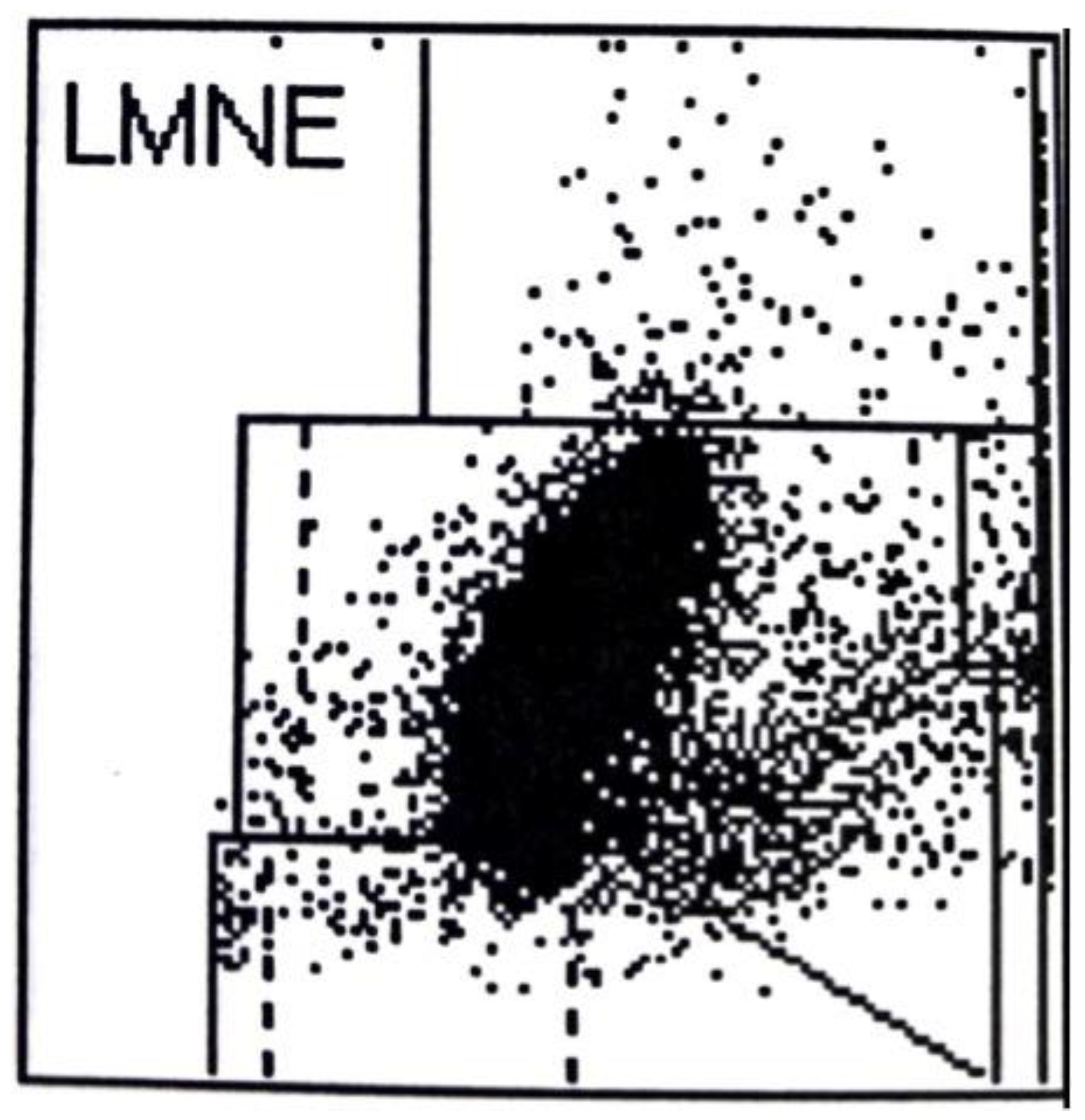
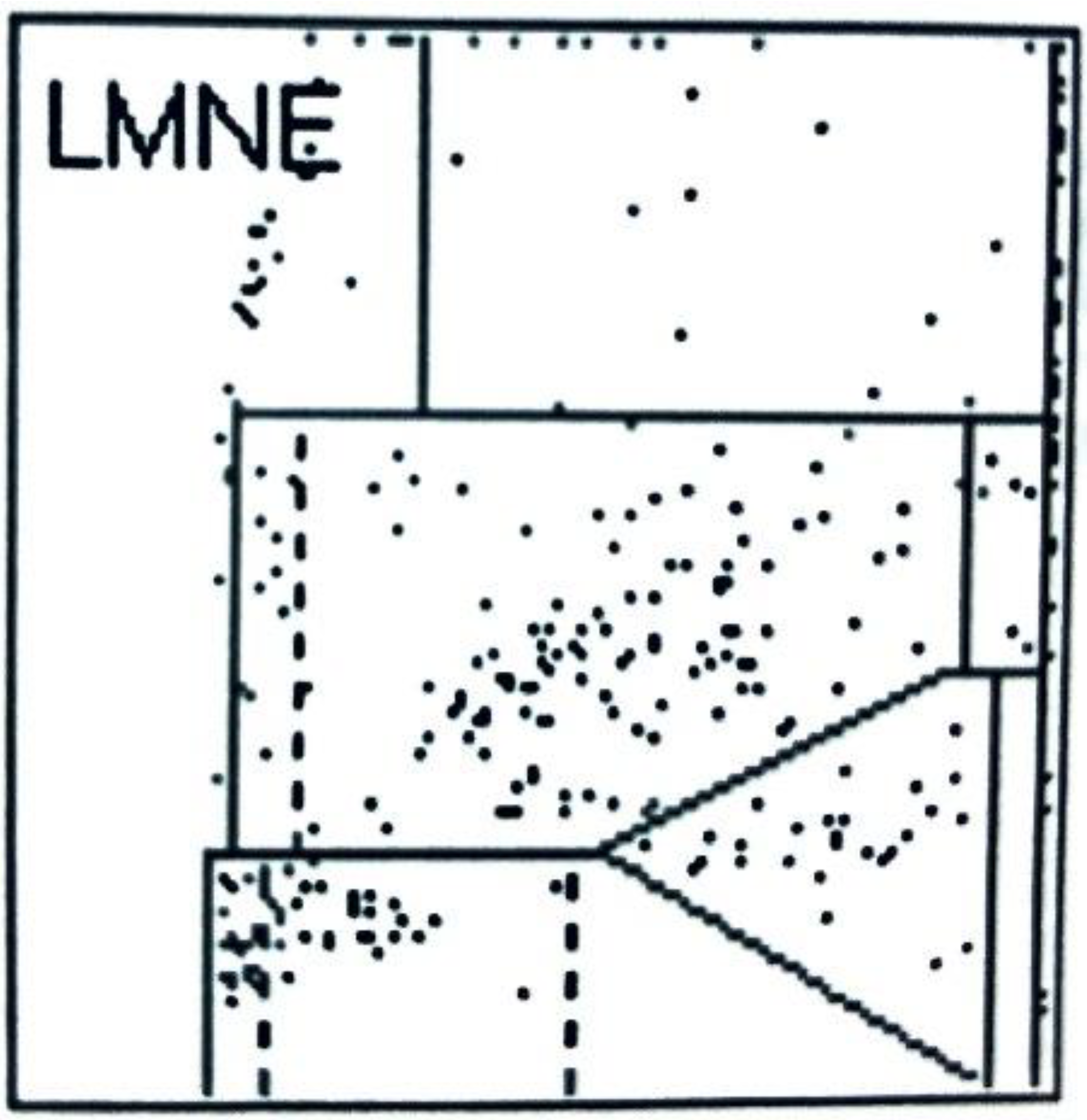
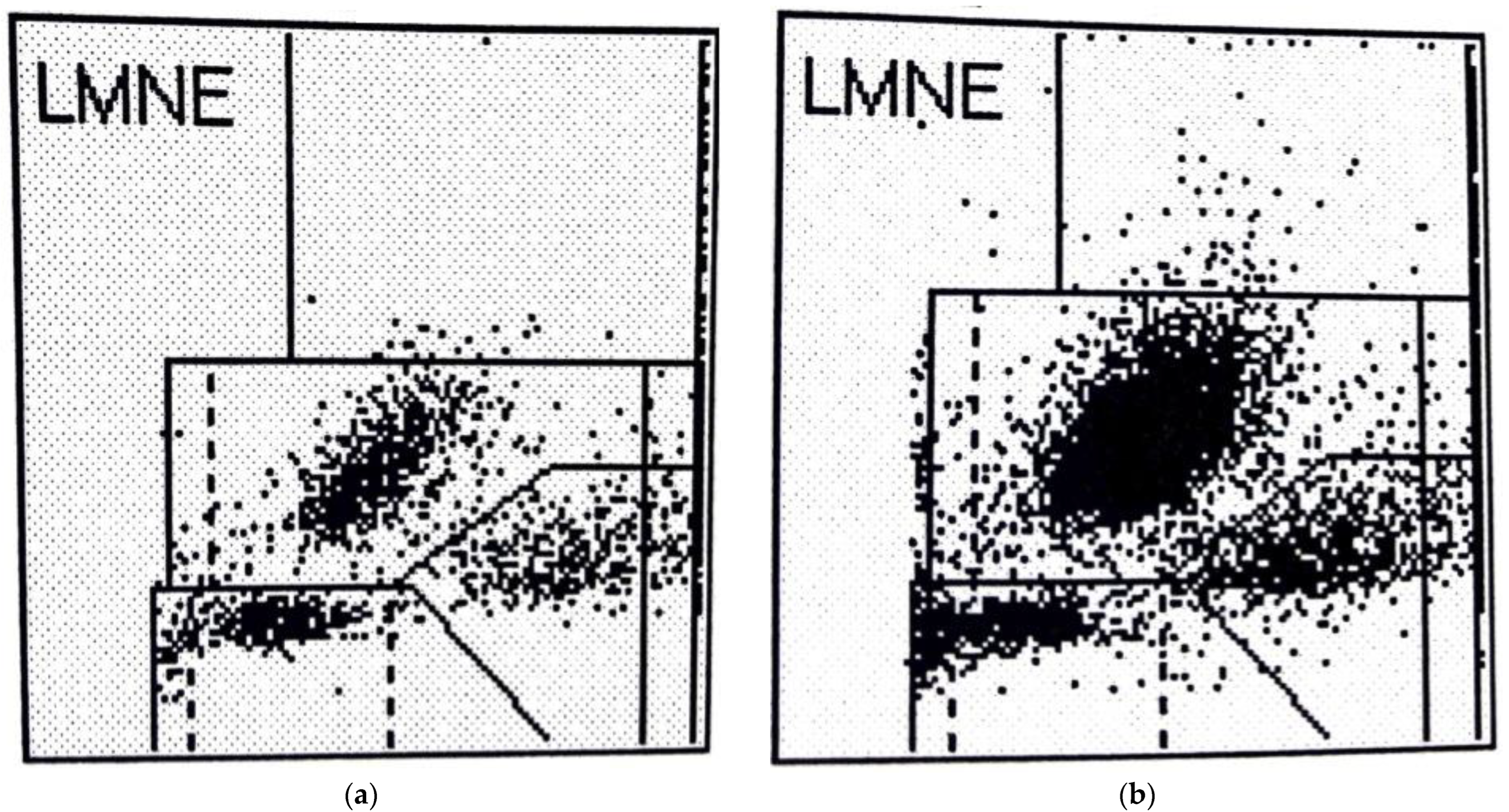
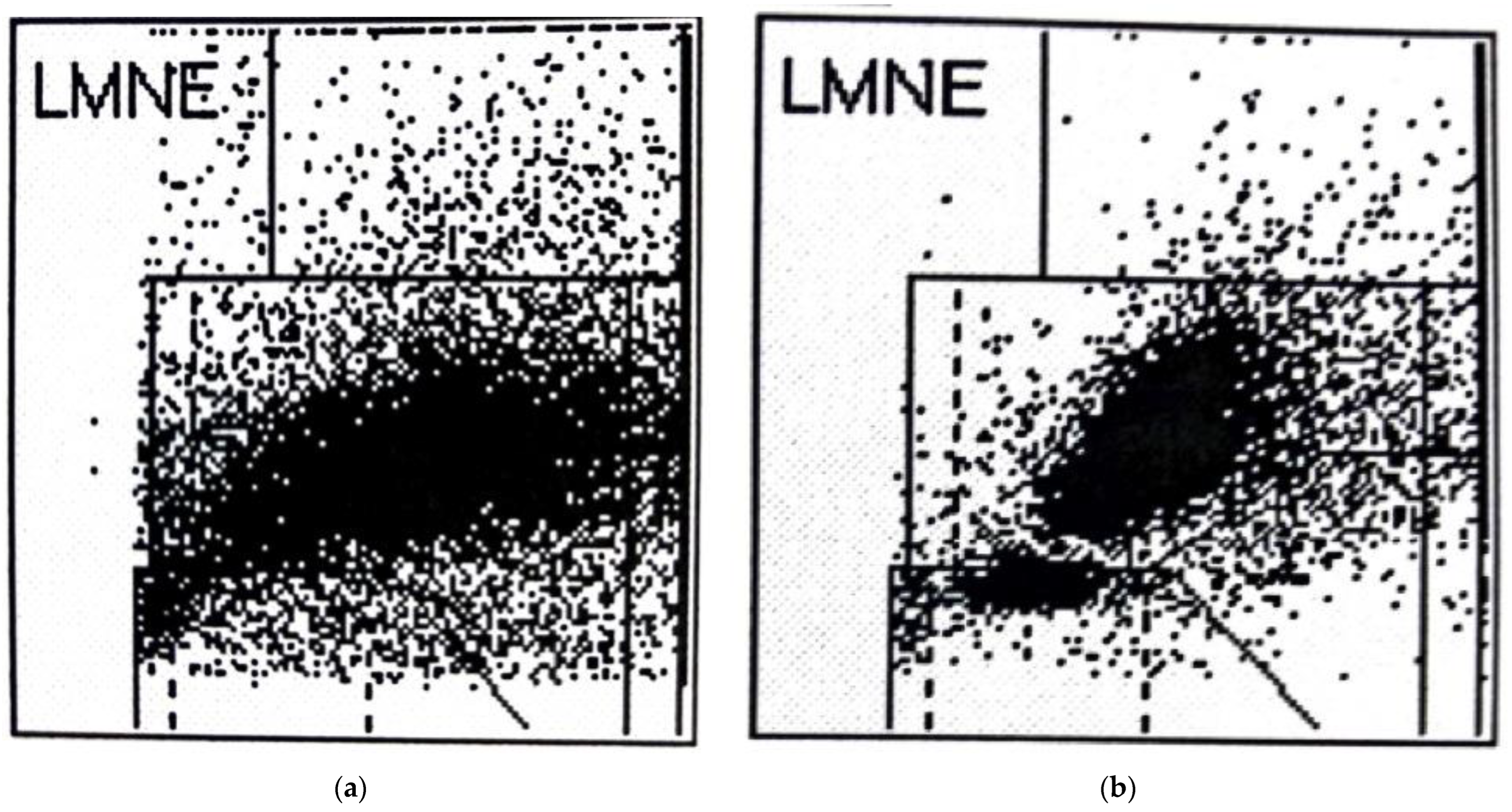
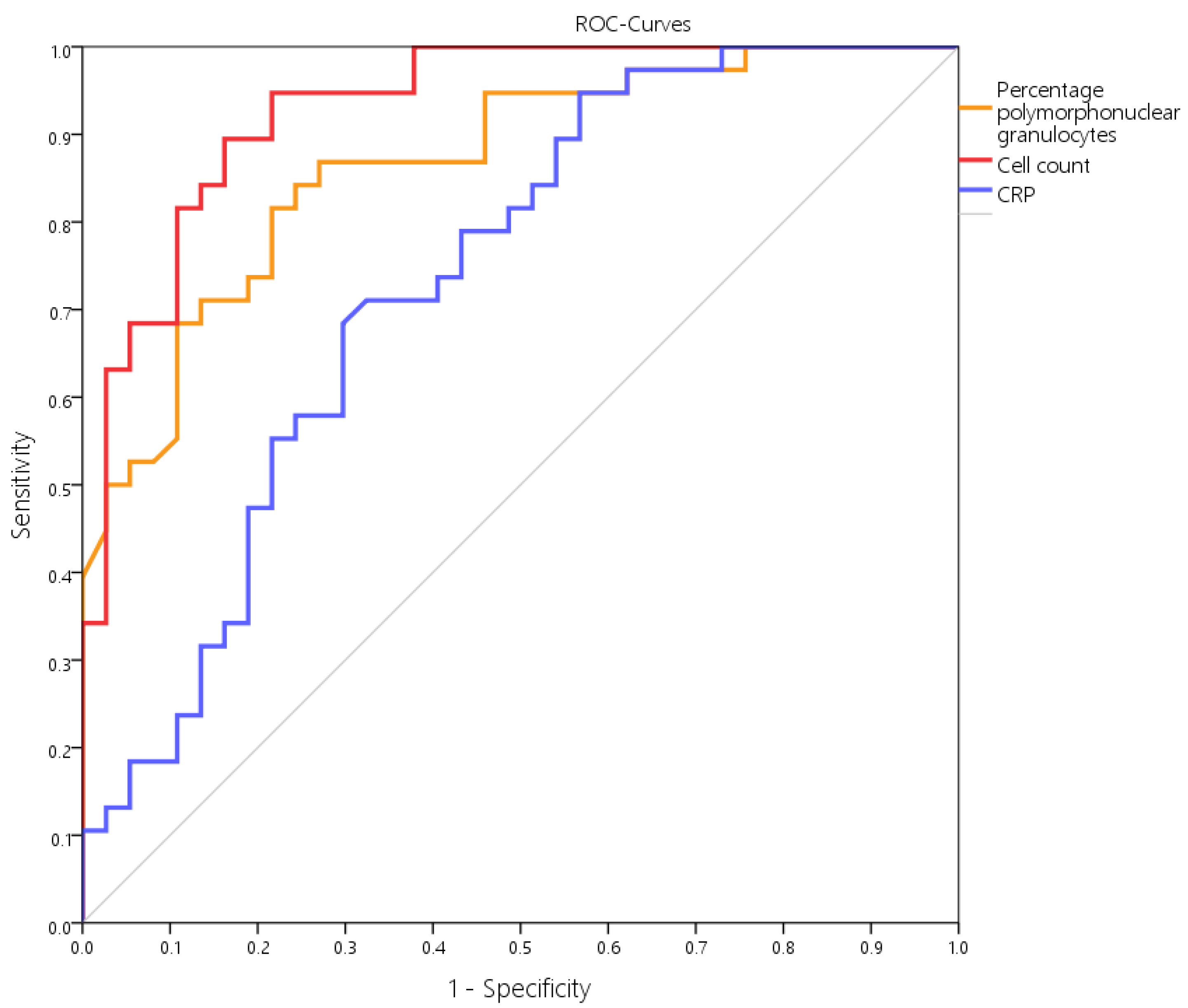
| Microorganism | Early Infection N = 38 |
|---|---|
| Staphylococcus aureus | 18 (47.4%) |
| Staphylococcus epidermidis—MSSE | 12 (31.6%) |
| Staphylococcus epidermidis—MRSE | 1 (2.6%) |
| Staphylococcus capitis | 3 (7.9%) |
| Staphylococcus lugdunensis | 1 (2.6%) |
| Cutibacterium acnes | 2 (5.3%) |
| Streptococcus agalactiae | 1 (2.6%) |
| Infection | Accuracy | 98.7% | LR Pos. | LR Neg. | ||||
| yes | no | Sensitivity | 100.0% | |||||
| LMNE | Infection | 38 | 1 | 39 | Specificity | 97.3% | 37.0 | 0.0 |
| No infection | 0 | 36 | 36 | PPV | 97.4% | |||
| 38 | 37 | 75 | NPV | 100.0% | ||||
| Infection | Accuracy | 62.7% | LR pos. | LR neg. | ||||
| yes | no | Sensitivity | 47.4% | |||||
| CRP | ≥100 mg/L | 18 | 8 | 26 | Specificity | 78.4% | 2.19 | 0.67 |
| <100 mg/L | 20 | 29 | 49 | PPV | 69.2% | |||
| 38 | 37 | 75 | NPV | 59.2% | ||||
| Infection | Accuracy | 64.0% | LR pos. | LR neg. | ||||
| yes | no | Sensitivity | 50.0% | |||||
| CRP | ≥90 mg/L | 19 | 8 | 27 | Specificity | 78.4% | 2.31 | 0.64 |
| <90 mg/L | 19 | 29 | 48 | PPV | 70.4% | |||
| 38 | 37 | 75 | NPV | 60.4% | ||||
| Infection | Accuracy | 65.3% | LR pos. | LR neg. | ||||
| yes | no | Sensitivity | 60.5% | |||||
| CRP | ≥75 mg/L | 23 | 11 | 34 | Specificity | 70.3% | 2.04 | 0.56 |
| <75 mg/L | 15 | 26 | 41 | PPV | 67.6% | |||
| 38 | 37 | 75 | NPV | 63.4% | ||||
| Infection | Accuracy | 84.0% | LR pos. | LR neg. | ||||
| yes | no | Sensitivity | 78.9% | |||||
| Cell Count | ≥10,000/µL | 30 | 4 | 34 | Specificity | 89.2% | 7.3 | 0.24 |
| <10,000/µL | 8 | 33 | 41 | PPV | 88.2% | |||
| 38 | 37 | 75 | NPV | 80.5% | ||||
| Infection | Accuracy | 76.0% | LR pos. | LR neg. | ||||
| yes | no | Sensitivity | 73.7% | |||||
| PME [%] | ≥79.5 | 28 | 8 | 36 | Specificity | 78.4% | 3.41 | 0.34 |
| <79.5 | 10 | 29 | 39 | PPV | 77.8% | |||
| 38 | 37 | 75 | NPV | 74.4% | ||||
| Infection | Accuracy | 66.7% | LR pos. | LR neg. | ||||
| yes | no | Sensitivity | 34.2% | |||||
| PME [%] | ≥90 | 13 | 0 | 13 | Specificity | 100.0% | >200.0 | 0.66 |
| <90 | 25 | 37 | 62 | PPV | 100.0% | |||
| 38 | 37 | 75 | NPV | 59.7% | ||||
| Infection | Accuracy | 72.0% | LR pos. | LR neg. | ||||
| yes | no | Sensitivity | 50.0% | |||||
| Cell Count ≥ 10,000/µL AND PMN ≥ 79.5% | yes | 19 | 2 | 21 | Specificity | 94.6% | 9.25 | 0.53 |
| no | 19 | 35 | 54 | PPV | 90.5% | |||
| 38 | 37 | 75 | NPV | 64.8% | ||||
| Infection | Accuracy | 64.0% | LR pos. | LR neg. | ||||
| yes | no | Sensitivity | 28.9% | |||||
| Cell Count ≥ 10,000/µL AND PMN ≥ 90.5% | yes | 11 | 0 | 11 | Specificity | 100.0% | >200.0 | 0.71 |
| no | 27 | 37 | 64 | PPV | 100.0% | |||
| 38 | 37 | 75 | NPV | 57.8% | ||||
| Infection | Accuracy | 92.0% | LR pos. | LR neg. | ||||
| yes | no | Sensitivity | 84.2% | |||||
| Cultures of aspirate | positive | 32 | 0 | 32 | Specificity | 100.0% | >200.0 | 0.16 |
| negative | 6 | 37 | 43 | PPV | 100.0% | |||
| 38 | 37 | 75 | NPV | 86.0% | ||||
Publisher’s Note: MDPI stays neutral with regard to jurisdictional claims in published maps and institutional affiliations. |
© 2022 by the authors. Licensee MDPI, Basel, Switzerland. This article is an open access article distributed under the terms and conditions of the Creative Commons Attribution (CC BY) license (https://creativecommons.org/licenses/by/4.0/).
Share and Cite
Fink, B.; Hoyka, M.; Weissbarth, E.; Schuster, P.; Berger, I. A New Graphic Type Differentiation of Cell Account Determination for Distinguishing Acute Periprosthetic Joint Infection from Hemarthrosis. Antibiotics 2022, 11, 1284. https://doi.org/10.3390/antibiotics11101284
Fink B, Hoyka M, Weissbarth E, Schuster P, Berger I. A New Graphic Type Differentiation of Cell Account Determination for Distinguishing Acute Periprosthetic Joint Infection from Hemarthrosis. Antibiotics. 2022; 11(10):1284. https://doi.org/10.3390/antibiotics11101284
Chicago/Turabian StyleFink, Bernd, Marius Hoyka, Elke Weissbarth, Philipp Schuster, and Irina Berger. 2022. "A New Graphic Type Differentiation of Cell Account Determination for Distinguishing Acute Periprosthetic Joint Infection from Hemarthrosis" Antibiotics 11, no. 10: 1284. https://doi.org/10.3390/antibiotics11101284
APA StyleFink, B., Hoyka, M., Weissbarth, E., Schuster, P., & Berger, I. (2022). A New Graphic Type Differentiation of Cell Account Determination for Distinguishing Acute Periprosthetic Joint Infection from Hemarthrosis. Antibiotics, 11(10), 1284. https://doi.org/10.3390/antibiotics11101284





